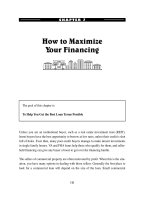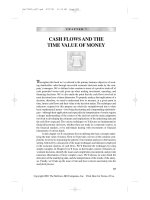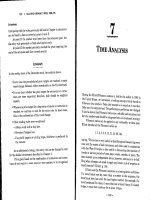Chapter 7 liability
Bạn đang xem bản rút gọn của tài liệu. Xem và tải ngay bản đầy đủ của tài liệu tại đây (330.67 KB, 26 trang )
OPEN UNIVERSITY HCMC
MBA PREPARATORY COURSE
Principles of Financial
Accounting
Lecturer: NGUYEN TAN BINH
06/04/16
NGUYEN TAN BINH - PHAN DUC DUNG
1
Chapter 7
Liabilities and Interest
06/04/16 NGUYEN TAN BINH - PH
2
Learning Objectives
After studying this chapter, you should be able to:
Account for current liabilities.
Design an internal control system for cash disbursements.
Explain simple long-term liabilities.
Relate bond covenants to the riskiness of a bond.
Interpret deferred tax liabilities.
Locate and understand the contingent liabilities
information in a company’s financial statements.
Use ratio analysis to assess a company’s debt levels.
06/04/16 NGUYEN TAN BINH - PH
3
Liabilities in Perspective
Liabilities are a company’s obligations to pay cash or to
provide goods and services to other companies or
individuals.
Accrual accounting recognizes expenses when they occur
rather than when they are paid.
When an expense is recognized before it is
paid, a liability is created.
06/04/16 NGUYEN TAN BINH - PH
4
Liabilities in Perspective
Liabilities are important to investors, financial analysts,
management, and creditors.
Excess liabilities often cause investors and
creditors to stay away from the company with
the excess liabilities.
06/04/16 NGUYEN TAN BINH - PH
5
Liabilities in Perspective
Liabilities are classified as either current or long
term to help readers interpret the immediacy of a
company’s obligations.
Current liabilities - obligations that fall due within the
coming year or within the company’s normal operating
cycle
Long-term liabilities - obligations that fall due
beyond one year from the balance sheet date
If long-term liabilities are paid gradually, the portion that comes
due within the year becomes a current liability.
06/04/16 NGUYEN TAN BINH - PH
6
Liabilities in Perspective
In the general ledger, each liability (wages, salaries,
interest, etc.) is kept in a different account.
However, in the financial statements, liabilities may
be combined and shown as a single amount.
The terms “accrued” or “payable” may
sometimes be used to denote liabilities.
06/04/16 NGUYEN TAN BINH - PH
7
Liabilities in Perspective
Presentation of liabilities in the balance sheet:
Current liabilities
Current maturities of long-term debt
Accounts payable
Wages payable
Interest payable
Total current liabilities
06/04/16 NGUYEN TAN BINH - PH
$19,500
26,250
1,750
2,500
$50,000
8
Accounting for Current
Liabilities
Not all current liabilities are recorded the same way.
Some are the result of a transaction with a
third party, such as a supplier or a lender.
Some are the result of an adjusting
journal entry made to acknowledge
an obligation arising
over time, such
as
interest or wages.
06/04/16 NGUYEN TAN BINH - PH
9
Accounts Payable
Accounts payable (or trade accounts payable) are
amounts owed to suppliers.
Large sums of money flow through accounts
payable systems, so data-processing and internal
control systems are carefully designed for
accounts payable.
The company must ensure that checks are written only
for legitimate obligations of the company.
06/04/16 NGUYEN TAN BINH - PH
10
Notes Payable
Promissory note (note payable) - a
written promise to repay principal plus
interest at specific future dates
Notes payable can be classified as
current or long term depending on
when they are payable.
06/04/16 NGUYEN TAN BINH - PH
11
Notes Payable
Rather than having to apply for many small
loans at different times, companies obtain
lines of credit with lenders.
Line of credit - an agreement with a bank to
automatically provide short-term loans up to some
preestablished maximum
The lender does not have to do extensive paperwork or
credit checks every time a borrower needs money.
The borrower has a preset amount of borrowing available.
06/04/16 NGUYEN TAN BINH - PH
12
Notes Payable
Companies sometimes borrow directly from investors
in the form of commercial paper.
Commercial paper - a short-term debt contract
issued by prominent companies that borrow directly
from investors
These liabilities usually fall due within 9
months, often within 60 days.
06/04/16 NGUYEN TAN BINH - PH
13
Current Portion of
Long-Term Debt
If long-term liabilities are paid gradually, the portion that
comes due within the year becomes a current liability.
The journal entry to reclassify a liability is:
Long-term debt
Current portion of long-term debt
xxxx
06/04/16 NGUYEN TAN BINH - PH
xxxx
14
Internal Controls Over
Payables
Since huge sums of money flow through payables
systems, good internal control must be present to
ensure that all payments involve properly
approved and valid obligations of the company.
Most disbursement systems require payments to be
made only by checks because the prenumbered checks
make record keeping easier.
All checks issued must be supported by source
documents.
06/04/16 NGUYEN TAN BINH - PH
15
Internal Control Over
Payables
Before a check can be written, a series of source
documents must be completed to document the
obligation.
Purchase order - a document that specifies the items
ordered and the price to be paid by the company
Receiving report - a document that specifies the
items received by the company and their condition
Invoice - a bill from the seller to a buyer indicating the
number of items shipped, their prices, any additional
costs such as shipping, and payment terms
06/04/16 NGUYEN TAN BINH - PH
16
Long-Term Liabilities
Some long-term liabilities are much like some shortterm liabilities except for the time frame.
Car loans or mortgage loans are much like
notes payable, but they are for a longer
term.
As time passes, payments of interest and
principal eliminate the loan obligation.
06/04/16 NGUYEN TAN BINH - PH
17
Long-Term Liabilities
Illustration and analysis of a loan:
Assume that $10,000 is borrowed at
10% interest. The yearly payment
is to be $3,154.71 for four years on
December 31 of each year.
The total repayment amount is
$12,618.83, which consists of the
$10,000 principal plus $2,618.83 in
interest.
06/04/16 NGUYEN TAN BINH - PH
18
Bonds and Notes
Both bonds and notes are legal contracts that
specify how much is to be borrowed and the
dates and amounts for repayment by the
borrower.
Notes and bonds are called negotiable
financial instruments because they can be
transferred from one lender to another.
Some bonds and notes are private
placements, which means that only a few
sources of borrowing are used rather than the
general public.
06/04/16 NGUYEN TAN BINH - PH
19
Bonds and Notes
Bond - a formal certificate of indebtedness
that is typically accompanied by (1) a promise
to pay interest in cash at a specified annual
rate plus (2) a promise to pay the principal at
a specific maturity date
The interest rate is often called the nominal
interest rate, contractual rate, coupon rate, or
stated rate.
The principal amount is also known as the face
amount.
06/04/16 NGUYEN TAN BINH - PH
20
Bonds and Notes
Interest rate - the percentage applied to a
principal amount to calculate the amount of
interest that must be paid on the loan
Interest represents the return the
lender can earn for loaning money.
In general, riskier loans demand higher
interest rates.
06/04/16 NGUYEN TAN BINH - PH
21
Bond Accounting
On December 31, 2000, a company issued $10,000,000 in 2year, 10% bonds. Interest is to be paid semiannually on
June 30 and December 31. Assuming that the bonds are held
to maturity, the journal entries are:
To record the issuance of the bonds
Cash
10,000,000
Bonds payable
10,000,000
To record the payments of the semiannual interest
Interest expense
500,000
Cash (($10,000,000 x 10%) / 2)
500,000
To record the repayment of principal at maturity
Bonds payable
10,000,000
Cash
10,000,000
06/04/16 NGUYEN TAN BINH - PH
22
Debt Ratios and
Interest-Coverage Ratios
Debt ratios are used to measure the extent to which
a company has used borrowing to finance its
activities.
The more borrowing, and the less equity,
the riskier it is to lend money to a firm.
06/04/16 NGUYEN TAN BINH - PH
23
Debt Ratios and
Interest-Coverage Ratios
Total liabilities
Debt-to=
equity ratio
Total shareholders' equity
Long-termTotal long-term debt
debt-to-total- =
Total shareholders’ equity + long-term debt
capital ratio
06/04/16 NGUYEN TAN BINH - PH
24
Debt Ratios and
Interest-Coverage Ratios
Debt-toTotal liabilities
total-assets =
Total
assets
ratio
InterestPretax income + Interest expense
coverage =
Interest expense
ratio
06/04/16 NGUYEN TAN BINH - PH
25









